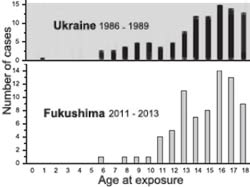http://www.asyura2.com/15/genpatu42/msg/848.html
| Tweet |
Officials: 6,000% cancer rate increase in Fukushima children’s thyroids — Expert: Urgent countermeasures against the suspected outbreak are necessary — Professor: Gov’t stopped me from checking thyroid exposure levels after 3/11 (VIDEO)
関係者:福島の子供の甲状腺で癌発生率が60倍に増加 - 専門家:(癌)疑いの発生に対し緊急の対策が必要です – (弘前大学) 床次眞司(トコナミ・シンジ)教授:3/11後、政府(福島県)は私が甲状腺被曝レベルをチェックするのを止めました(動画)
Published: May 19th, 2015 at 7:05 pm ET By ENENews
公開:2015年5月19日、19:05 ET ENENewsによる

Asahi Shimbun, May 19, 2015 (emphasis added): Fukushima finds 16 new cases of thyroid cancer in young people… authorities said May 18, although they added it is “unlikely” a direct result of the nuclear accident…The 16 new cases were detected between January and March, and bring the total number of young people diagnosed with the disease in the testing program to 103… 127 [have been diagnosed or suspected of having thyroid cancer]… many cases of thyroid cancer in infants were reported after the 1986 Chernobyl disaster. However, this has not proven to be the case so far with regard to the Fukushima nuclear crisis.
朝日新聞英語版、2015年5月19日(強調は記者):福島で、若年者に甲状腺癌の新しいケースが16人見つかりました...と当局は5月18日に述べました、彼らはそれが原発事故の直接の結果「ではなさそう」と追加しましたが。...16人の新たな症例は1〜3月の間に検出されました、そして103人へのテスト・プログラムで病気と診断された若年者の数を合計しました... 127人が [甲状腺癌と診断された、もしくは疑われています] ... 1986年チェルノブイリ事故後に、乳児の甲状腺癌の多くの症例が報告されました。しかしながら、これまで福島核危機に関して、これがそのケースであるとは証明されていません。
Fukushima Voice, May 19, 2015: The Thyroid Examination Evaluation Subcommittee… came to a conclusion [that this] clearly represents an excess incidence… by an order of magnitude (At the November 11, 2014 subcommittee meeting, it was described as “61 times“)… this increase can be a result of either excess occurrence due to radiation exposure or over-diagnosis… “it is not possible to conclude if thyroid cancer cases detected during the screening are radiation-induced… it is unlikely these cases are the effect of radiation exposure… the exposure dose is far less than the Chernobyl accident and that there have been no cancer cases in children younger than 5… early internal exposure dose from radioactive iodine is extremely critical in assessing the effect of the accident.”
福島の声、2015年5月19日:甲状腺検査評価分科会は...[これは]明らかに(被爆の)大きさの順による...過剰発生率を表している、との結論に達しました、(2014年11月11日において、「61回」分科会と記載される)...この増加は、放射能被曝が原因による過剰発生、あるいは過剰診断のいずれかの結果であり得ます... 「もし甲状腺癌の症例がスクリーニング時に検出されたならば放射能誘発性です、と結論することはできません...これらのケースが放射能被曝の影響である可能性は低いです...被曝量は、チェルノブイリ事故よりもはるかに少ないです。5歳未満の子供には癌症例がなかったです...放射性ヨウ素による早期の内部被曝線量は、事故の影響を評価する上で極めて重要です。」
The subcommittee and Asahi article discount the link between these cancers and the Fukushima disaster due to a lack of cases among infants. Asahi claims this is unlike Chernobyl, where “many cases of thyroid cancer in infants” had developed. Is this accurate? According to Shinichi Suzuki, who was in charge of the Fukushima Thyroid Examination, March 2015: “There is a striking similarity between the [age] profiles of patients diagnosed during the period of latency after Chernobyl in Ukraine and currently in Fukushima.”
分科会と朝日新聞の記事は、乳児のケースが不足しているため、これらの癌と福島の災害との間の関連性を割り引いています。朝日新聞は、これはチェルノブイリとは異なっていると主張します、そこでは(チェルノブイリでは)、乳児の甲状腺癌の多くのケースが発病していた。この事は正確ですか?2015年3月に福島甲状腺検査を担当した鈴木真一によれば、:「ウクライナのチェルノブイリ後と福島の現在の間に、潜伏期間中に診断された患者の[年齢]の構成(プロフィール)に顕著な類似性があります。
Also, the subcommittee noted “the early internal exposure dose from radioactive iodine is extremely critical in assessing the effect of the accident” — what does that dose data show?
"また、分科会は「放射性ヨウ素からの早期内部被ばく線量は事故の影響を評価する上で極めて重要である」ことを指摘しました - その線量データは何を示しているのでしょうか?
Japan Focus, Dec 8, 2014: Sakiyama Hisako, former senior researcher at the National Institute of Radiological Sciences… observed that power was deployed to stop measurements of thyroid exposure being taken… Professor Tokonami Shinji of Hirosaki University… tried to measure exposure levels immediately after the explosions [but] was halted by Fukushima Prefecture, which accused him of stirring up trouble… Tokonami went on to test 65 Fukushima residents one month after the explosions [and] found radioactive iodine in the thyroids of 50 out of the 65 (77%)… He estimated the equivalent dose to the thyroid [was up to] 87 mSv [and] infants who remained in areas with high iodine levels may have been exposed to over 100 mSv.
日本の焦点、2014年12月8日:崎山比早子、放射線医学総合研究所の元主任研究員は...権力が甲状腺被曝の測定を行うことを停止するように展開したことを観察しました...弘前大学の床次眞司(トコナミ・シンジ)教授は... [爆発した後直ぐに被曝レベルの測定を試みました[しかし]、福島県が止(と)めました、福島県はトラブルを巻き起こすと彼を非難しました... 床次は[爆発1ヶ月後に65人の福島住民をテストするために行きました、[そして] 65人のうち50人(77%)の甲状腺に放射性ヨウ素を発見しました...彼は、甲状腺への等価線量は87ミリシーベルト[が最大であった]と推定しました、[そして]高いヨウ素レベルのエリアに残った乳児は、100ミリシーベルト以上被爆している可能性があります。
FUKUDEN Fukushima Beacon for Global Citizens Network (pdf), Dec 31, 2014: Prof. Toshihide Tsuda, an epidemiology specialist [said] “When we analyzed the results of the thyroid cancer survey conducted in the Fukushima Prefecture according to location, it is obvious that there are more numbers of thyroid cancer cases in the Nakadori area (middle area), and we urgently need to take necessary measures.”
地球市民ネットワークのための福島ビーコン(=標識、灯台) (PDFファイル)、2014年12月31日:津田敏秀教授、疫学の専門家は「我々は、場所に応じて福島県で行われた甲状腺癌調査の結果を分析すると、より多くの甲状腺癌の症例数が中通りエリア(福島県の中間エリア)に存在することが明らかである、そして我々は、緊急に必要な措置を取る必要があります。」と[言いました]
Prof. Tsuda, Eiji Yamamoto & Etsuji Suzuki of Okayama Univ.: [The thyroid cancer] incidence rate ratio was 26.98… in the nearest area, and in Fukushima city, it was 19.41… compared with the Japanese mean… [E]xcess incidence rate ratios were observed… Dose-response relationship by distance from the plant was indicated… countermeasures against the suspected outbreak are necessary in Fukushima and the neighboring areas.
岡山大の津田教授、山本英二&鈴木越治:[甲状腺癌]罹患率の比は、最も(原発に)近い地域で... 26.98で、福島市では、日本人の平均と比較して... 19.41でした... [過]剰な罹患率比が観察されました...原発からの距離による線量-反応(相関)関係が示された...(甲状腺癌)疑い発生への対策は、福島と近隣地域に必要とされる。
Watch a presentation by Prof. Tsuda here
ここで津田教授によるプレゼンテーションを見ます
|
|
|
|
投稿コメント全ログ コメント即時配信 スレ建て依頼 削除コメント確認方法
▲上へ ★阿修羅♪ > 原発・フッ素42掲示板 次へ 前へ
|
|
 スパムメールの中から見つけ出すためにメールのタイトルには必ず「阿修羅さんへ」と記述してください。
スパムメールの中から見つけ出すためにメールのタイトルには必ず「阿修羅さんへ」と記述してください。すべてのページの引用、転載、リンクを許可します。確認メールは不要です。引用元リンクを表示してください。